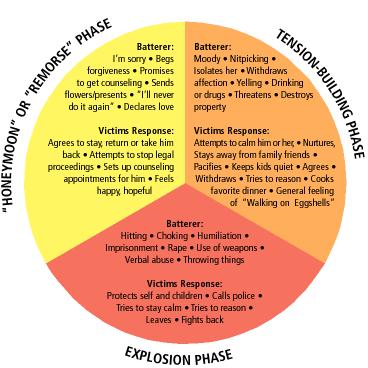The Cycle of Violence
Psychologist Lenore Walker devolved the cycle of violence in the 1970s. In her work with survivors of abuse, she was able to recognize a pattern, which was common among those abused. This pattern became known as the cycle of violence. There are 3 phases in an abusive relationship; these phases are often repeated over and over.
Phase 1: Tension Building
The start of things to come, a woman notices the anger starting to build in her partner. The once thought of minor outbursts happen more frequently and she can sense the tension building. Tension builds within the abuser and his behavior becomes more aggressive and intense regardless of how hard the victims tries to calm him down. He is often critical; he yells, swears, and threatens.
Early in the relationship, she may try to nurture and be compliant to his needs. She wants to hold on to the love so she endures the incidents of abuse.
Phase 2: Acute Phase (Explosion)
The tension building phase ends with the explosion. In this phase the batter loses control both emotionally and physically. He uses aggression and violence to frighten and control his partner. His anger results in physical injury to the woman, as well as long term emotional debilities.
Sometimes during this phase, a woman will try to fight back against the abuser, but most often she chooses to receive her beating and not anger him further.
The acute phase is usually short and malicious. The consequences can be severe injury or even death. This is usually the phase where law enforcement becomes involved. When law enforcement arrives, the abuser often appears calm after the release of the tension, whereas his partner may appears confused and hysterical from the incident.
Phase 3: The Honeymoon
In this phase the abuser becomes perfectly calm, loving, kind and apologetic. The abuser’s behavior in this phase may give the woman a false sense of security and hope. He often promises to change and to never hurt her again. He will often bring her gifts, such as flowers, as a peace offering.
This is the most dangerous phase because; the victim can be drawn back in by the batterer’s charm and manipulation.
Understanding the cycle is important to people working with women in abusive relationships. It is also important to realize women do not look for abusive men, they can appear to be warm, friendly, attentive, and caring.
Eventually the cycle shortens and the honeymoon phase becomes shorter and shorter and may even cease to exist.
